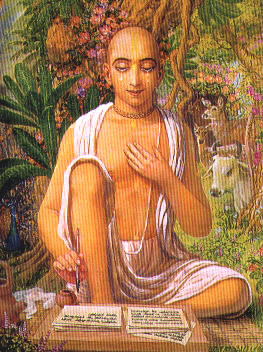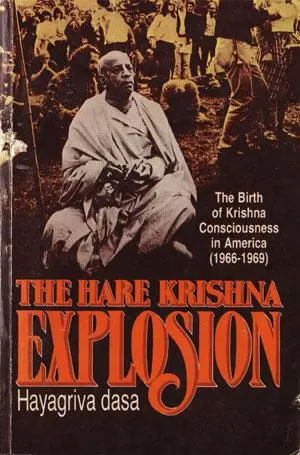
Today is the Appearance Day of Srila Jiva Goswami, one of the six Goswamis of Vrindavan, and direct disciples of Sri Caitanya Mahaprabhu.
Srila Jiva Goswami
Srila Jiva Goswami was the son of Sri Vallabha and nephew of Sri Sanatana, Sri Rupa, all of whom were employed in the service of the Badsha Hussein Shah. Having been rewarded richly by the Badsha for their devices, their household life was very opulent.
When Sri Chaitanya Mahaprabhu came to Ramakeli, Sri Jiva was blessed by having darshana of his worshipable Lord, though he was just a baby at that time. Mahaprabhu indicated him to be a great future scholar in the Gaudiya sampradaya. Though he was only a child, Sri Jiva would meditate on Sri Chaitanya constantly.
Later on, when his father and uncles renounced their family life in order to be with Mahaprabhu, the only child, Sri Jiva, was left with his mother in the family palace at Fateyabad. Jiva missed them greatly and whenever he would remember his father and uncles, or Sri Chaitanya he would lose consciousness.
As he grew up, Sri Jiva took up the worship of the Deities of Sri-Sri Rama-Krishna. He would carefully decorate Them and offer bhoga and arati, serving Them with his full attention. Even in his play, whatever games he played were connected with Sri Krishna’s pastimes.
While studying under the local pandits he became proficient in grammar, poetry and rhetoric. His teachers noted his great intellect.
When Sri Jiva learned that his father had passed away on the banks of the Ganga, he was completely unsettled. Family members and friends tried to console him but to little avail. Family life had become the source of his utter sadness. Someone suggested that he go to Navadvipa and see Lord Nityananda, so he set out for Navadvipa with a group of pilgrims. Everyone at Navadvipa was very happy to meet the nephew of Sri Rupa and Sanatana.
Sri Jiva spent some days with Nityananda Prabhu, touring the nine islands of Navadvipa, in order to visit the holy places of the Lord’s pastimes there. Then, as ordered by Nityananda Prabhu, he set out for Kashi (Varanasi). At Kashi he studied Vedanta under Sri Madhusudana Vachaspati, a disciple of Sarvabhauma Bhattacharya. The conclusions of Vedanta contained in Srimad-Bhagavatam that were expounded by Sri Chaitanya Mahaprabhu to Sarvabhauma Bhattacharya in Puri had been in turn taught by the Bhattacharya to Madhusudana Vachaspati, who established a school at Kashi.
From here Sri Jiva set out for Vrindavana where he received shelter at the lotus feet of his two uncles, Sri Rupa and Sanatana. Jiva stayed with Sri Rupa, who began to teach him Srimad-Bhagavatam. After initiating him with the divine mantra, Rupa engaged him in the service of Sri Sri Radha-Damodara.
Seeing that Jiva had quickly become conversant with the conclusion of Srimad-Bhagavatam, Sri Rupa engaged him in proof-reading his Bhakti-rasamrita-sindhu. At this time Sri Jiva compiled a commentary on Bhakti-rasamrita-sindhu called Durgama-sangamani. Sri Sanatana Goswami compiled Sri Vaishnava-tosani, a commentary on the tenth canto of Srimad-Bhagavatam, which he gave to Sri Jiva for proof-reading. Under the order of Sri Sanatana, Sri Jiva compiled a commentary on that named Laghu Vaishnava-tosani. His writings, along with those of Sri Rupa and Sri Sanatana, Sri Gopala Bhatta, Sri Raghunatha Bhatta, Sri Raghunatha Dasa, Sri Krishna Dasa, Sri Kashishvar Pandita, and Sri Madhu Pandita, completely captivated the learned men of that time.
It was the beginning of a golden age at Vrindavana. Sri Jiva regularly brought water for Sri Rupa and Sanatana’s bath. He massaged their heads with oil, cleaned their ashrama, worshiped the Deity, cooked and corrected manuscripts.
After the passing away of Sri Rupa and Sanatana, Sri Jiva continued the tradition that they had inaugurated. Once Sri Jiva travelled to Agra to debate with the Rajputs concerning the glories of Yamuna and Ganga rivers. He established that the Yamuna is more glorious than the Ganga as the Ganga emanates from Krishna ‘s lotus feet whereas the Yamuna is His own consort. At this the Mogul emperor was very much satisfied and wanted to present him something. Sri Jiva replied that he would accept some blank papers. So the emperor presented Jiva some stained paper. (At that time paper was very rare and most manuscripts were usually composed on leaves.) There is also a legend that once, when a Mogul emperor (possibly Akbar) wanted to confer something on the Goswamis of Vrindavana, they requested a farman (emperor’s order) that no living beings would be killed within Vraja. As a result of this no king would come to hunt there anymore.
The disciple of Lokanatha Goswami, Narottama Dasa Thakura Mahashaya, Sri Gopala Bhatta Goswami’s disciple Srinivasa Acharya Prabhu, and the disciple of Chaitanya Prabhu, Sri Shyamananda Prabhu, were greatly favoured by Srila Jiva Goswami. Under his tutelage they studied all the literatures of the Goswamis. Later he sent them to preach this knowledge in Bengal. Srila Jiva Goswami composed many literatures. He passed away in 1618 in Vrindavana.














Nov 05, 2011 @ 23:52:44
The image you have here of Jiva Goswami is not him. He´s really Srila Vishwanath Chakravarti Thakkur.